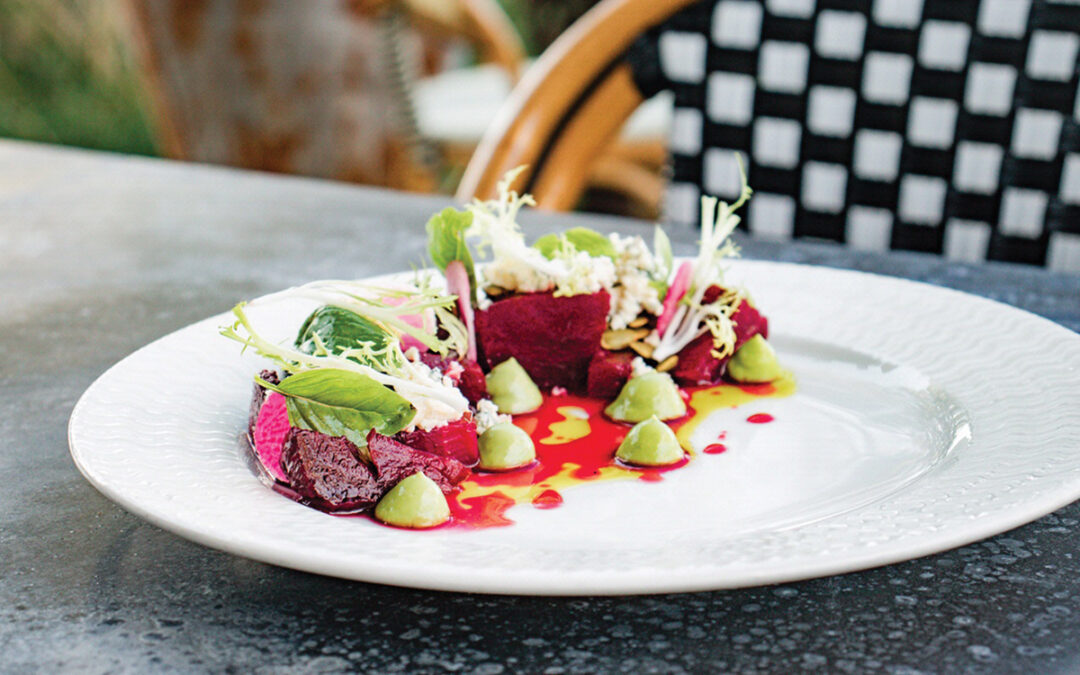It’s 7 o’clock on a Friday, and the sushi bar at Koi Kawa is buzzing with activity, while the dining room is still relatively empty — except for dutiful Dining Companion, of course; she’s always early, and I’ve given up trying to break her of the habit. The early arrival is useful in this case, however, as she spent three years living in Tokyo and has had at least a little time to peruse the menu. We both agree on one thing: For the most part, the dinner and a la carte fare, typical of Japanese restaurants in this country, is of little interest. We decide to ignore the standard sukiyakis, teriyakis, and flattened and breaded cutlets of chicken and pork. Instead, we embark on an ambitious program of what we come to call Tokyo tapas, searching the menu for smaller, but more compelling-sounding dishes, and after a good 15 minutes of cogitation — much to the distress of our waitress with fashion-model features (but the same air of distraction that one imagines fashion models must have — we come up with a list. Smug, and with a certain satisfaction, we convey our sushi-to-shishamo desires to said server. Oops; one-by one, the word comes back: no grilled black cod (I was really looking forward to this one); no uni sushi (sea urchin roe is a bellwether item in my book); no Kobe beefsteak (well, it was $25, so maybe we didn’t really need it after all).
And so we substitute — and speculate. Is this symptomatic of the current economy, in which risk-taking regarding ordering of products is discouraged (since everybody really wants the chicken, beef and shrimp shish kebabs broiled with teriyaki sauce we rejected), or is it just bad planning? But with the arrival of the first plates, speculation ceases and inspection begins – along with enjoyment. The orange smelt egg sushi bordered with green-black nori is stunningly beautiful, and the masago has a tingly, almost tinny saltiness that bursts on the tongue with the pop of each tiny, buckshot-sized roe. (Here’s a suggestion while it’s still early in the game: Ask for both the light and the regular soy sauces, adding in wasabi [horseradish] paste at will. Some dishes, such as the smelt egg, are best served with the lighter and less salty soy; others can use — and even require — the more powerful punch of the full-flavored brew.)
Silvery mackerel, a favorite of DC and currently in season, is simply placed atop a lozenge of sticky sushi rice, and it has a clean, almost pickled taste (it’s often marinated) that goes well with the stronger soy dip. The most artful package of all, however, is exemplified by the deceptively simple tamago, or “omelet” sushi. In Japan, tamago is considered a test of a sushi master’s art, and patrons have been known to order it first, only to leave in a huff of indignation (and without paying) if it didn’t meet their exacting standards. At Koi Kawa, a slab of golden omelet is bound to the rice with a narrow band of nori, and though the layers of egg are not paper-thin, as might be considered optimum in Japan, the cold egg mixture is appropriately and lightly sweet, and the light soy with a hint of wasabi suits it to a “T.” It should be mentioned, by the way, that at two pieces per order, Koi Kawa’s sushi is very fairly priced. No wonder the bar was crowded.
We are most impressed, however, by the kai no sakamushi, steamed clams in sake served in a blue Imari bowl. The warm, almost nutty, sake-infused broth plays beautifully against the briny clams –and offers a nice contrast to the cold Hakkaisan sake we had ordered to drink. Served in a clever carafe with a “pouch” for ice (DC thinks they would be great for martinis), the sake is at once yeasty and lightly floral, and the cool temperature keeps everything in balance.
We have avoided ordering both an exceptionally expensive sake (the economy, you know) and a cheaper, unfiltered brew, the latter being rejected not so much for its price but because, confides DC, “it’s what we used to drink warm at all the sumo wrestling matches.” Funny; she doesn’t seem like the sumo sort.
An order of three small grilled smelt (the shishamo, called “salt water fishes”) is Zen-like in its simplicity, and the fishes are especially good with the sake — but might be considered a little austere by many. Somewhere in the parade of plates, a dragon roll also appears. Despite the fact that elaborate rolls aren’t part of the classic canon, they can be fun (especially with names such as “bank roll”), and the dragon is a kind of catch-all, containing spicy tuna and smelt eggs inside, and barbecued eel, avocado and eel sauce on the outside. Smoky eel is a personal favorite, but in this instance it seems to overwhelm all the other ingredients: Neither the spicy tuna, the masago nor the avocado has a chance. In our audacity, we determine that, for both visual and taste reasons, some green “scales” would have been good (maybe the avocado applied on top of the eel sauce), but in the long run just give up and dunk each piece in the strong soy-wasabi blend. “If we weren’t pleased with something, we just used the strong soy,” says DC of her Tokyo years.
No palliative measures are needed with our Kobe substitute, the plate of beef yakiniku ordered Japanese barbecue (not teriyaki) style. Perhaps marinated, and certainly simply grilled, the thin pieces of flank-like beef have a great, lightly smoky flavor and a nicely yielding texture and are just the right amount to split after all that had gone before — which, by the way, had also included two tempura-battered soft shell crabs. With their delicate coating and just-rich-enough taste, the crabs land near the top of our evening’s favorites list — along with the clam broth and the yakiniku. An order of cucumber salad, alas, finds itself near the list’s bottom because of a thick, sesame-flavored dressing for which we would happily have substituted simple vinegar. You may safely leave without ordering dessert, but in case something slightly sweet seems required, here’s our take on the mochi ice cream. Wrapped in a rice-based skin, the green tea model has a perfumed flavor that neither of us liked, but the earthy and lightly sweet red bean version is right on target — even with the dregs of the subtle sake. Soy and sake, depending on how you use them, thus become weapons or partners in one’s exploration of a Japanese menu. May you never run short of either.
By Ron Bechtol









0 Comments